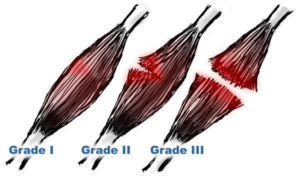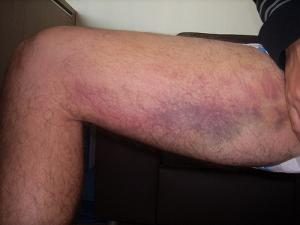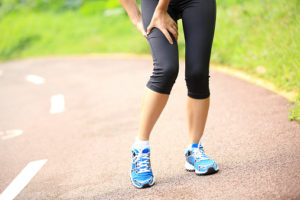DIY for a Pulled Muscle
We have an active, results-oriented population here at SSOR. Our patients are competing in many different activities, whether it’s recreationally, competitively, or just to stay in shape. Elite athletes pull muscles just like “regular Joe’s” do. The difference is that many regular Joe’s don’t have their sport as their job! Most of us are working regular jobs and taking care of our families. We just don’t have time to get treatment all day to get better after these like the pro athletes do. So if you pull a muscle, what should you do? There are many misconceptions about how to treat a pulled muscle. We’re experts in the treatment of pulled muscles here and sports physical therapists should be your first choice in treating them. There are varying degrees of severity of pulled muscles, so these suggestions have some caveats to them. Obviously, these should be treated by a professional, but for those of you who insist otherwise, here’s a summary of what you should do.


Signs of a Pulled Muscle
Typically when you pull a muscle, you know it! Most people report a stretching, tearing, or popping sensation that is painful. It hurts to stretch and if you try and run, it’s either not possible or very painful to do so. It’s usually very sore and hurts to do basic things like bend over or get in/out of the car. If you really did a number on yourself, you may have extensive bruising and be very tender at the site of the pulled muscle.
Why Do Pulled Muscles Happen?
There are many reasons why you pull muscles. You may have a strength imbalance. For example, hamstring strains are pretty common. Many people do exercises to strengthen the quadriceps but don’t also strengthen the hamstrings. The resulting muscle imbalance may lead to a strain. Another reason for pulled muscles is lack of flexibility. While there is some debate about this in the scientific literature, if you ask your muscles to reach their outer limits of flexibility during activity but don’t have the elasticity to get there, you might be at risk for a strain. If you don’t stretch regularly and try and leg out a triple in that rec league softball game, you might put yourself at risk. Third, you could be dehydrated. A good analogy is filet mignon versus beef jerky. With proper hydration, your muscles are like filet – tender, juicy, and less stiff. Hydrated muscles are more elastic and flexible. However, if you’re more dehydrated, your muscles are like beef jerky – they get tough and lose their elasticity. So, if you drink a ton of coffee without also drinking water or if you maybe are playing sports while drinking beer/s, you’re losing water from sweat and both coffee and alcohol are diuretics – they make you lose more water! Here’s a good link on proper hydration guidelines.
Can Pulled Muscles be Prevented?
You can certainly reduce the likelihood of these happening. If you look at the potential causes above, make sure you stay flexible, make sure you have balance in exercise routines, and make sure your water intake is adequate. A good warm-up routine to heat up your tissues to make them more “ready” for activity will help too. Activities like a light jog, jumping jacks, walking lunges, high knees, skipping, “butt kickers,” shuffling/defensive slide, and cariocas are just a few options. The idea is to “prime the system” before more intense activities take place. Finally, a great way to prevent pulled muscles is to stay active – it’s a bad idea to sit all all week or be a sedentary person, then ask muscles once in a while to perform at their best. It’s just not a good idea.
Treatment for a Pulled Muscle
The following are general guidelines for a pulled muscle. Keep in mind, there are different grades of pulled muscles and exercises will be a little different based on what muscle group you pulled. Additionally, you may have pulled the tendon rather than the muscle. Tendon strains take longer to heal than muscle strains do. You probably pulled your tendon if your pain is real close to the joint. So, if you pulled your hamstring, you got the tendon if it hurts real high near your glutes, or real low by the back of the knee. All that being said, here’s some things you might try:
- Rice, ice, compression the first 3-5 days. After a pulled muscle, there is a gap at the site of the tear, almost like frayed ends of a rope. The body will begin the healing process to try and “patch” the damage. Therefore, rest is critical and ice is as well to manage pain from the inflammatory process. During this time, there shouldn’t be any stretching, even though it feels tight. The repair is very weak and “immature” to handle stretch. Use a compressive wrap of some kind to support the muscle and to help minimize swelling. The worse the strain, the longer you should rest.
- Use a crutch/es if need be. Sometimes with these muscle pulls, it can cause people to limp. If that is the case, the scar tissue won’t lie down appropriately and will actually cause the muscle to shorten further. Use a crutch or a cane on the opposite side of the injury until walking is normal.
- Ride an exercise bike after the first 3-5 days. A good guideline to start is that it’s not tender to touch and you are able to walk normally. Riding an exercise bike not only helps move fluid out of the area but also gets the muscles contracting/relaxing in a non-impact, low intensity manner to help minimize further declines in function. No need to ride aggressively or for a long time – an easy 10-15 minute ride will suffice.
- Start stretching about day 5 after the injury. Stretches should be gentle and not painful. Hold stretches for 30 seconds and repeat 3-4 times per day. Stretching can start when walking is normal.
- Once range of motion is pain free, begin light resistance exercises. Depending on the muscle group, this could mean a multitude of exercises. Regardless, resistance should be light enough to allow full range of motion and limited pain. Repetitions should initially be high (20-30) and reduce as resistance increases. Consider doing step ups, lunges, and squats in a pain free range as well.
- Once resistance exercises are pain free, consider dynamic warm up activities. High knees, “butt kickers,” shuffling, cariocas, and jogging are all activities that you can attempt. Speed should gradually increase from 25%, then to 50%, then to 75%, and finally 100% effort gradually over the course of the next 2-3 weeks.
- Increase the speed of your exercises. To better replicate running and sprinting, your resistance exercises should also be performed quickly. This is only after the strength is restored. Do not sacrifice form, but go with lighter weight and perform repetitions fast.
- Once you get back to playing sports, dynamic stretch before, static stretch after. Research is supporting more activities like walking lunges, skipping, jumping jacks, and shuffling before activity to break a sweat, then do “place and hold” stretching afterwards.
- Consider wearing compressive shorts once you get back to playing.
- Ice after activity.
- Stay hydrated! If you are dehydrated, a muscle is more prone to pulls.
If you get a pulled muscle, look no further than the sports physical therapists here at SSOR to get you back to the activities you love to do. We have a competent and professional team of physical therapists to help you. It would be a privilege to serve you and partner with you in your care. (913) 728-8599 Remember, you can see a PT in Kansas without a physician referral, so don’t delay getting better!
Tags: Kansas City, muscle strain, Overland Park, physical therapist, Physical Therapy, prairie village, pulled muscle, sports physical therapist


